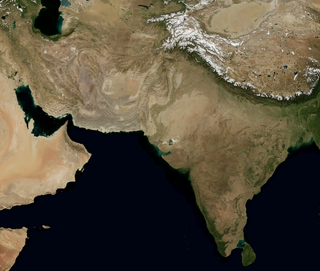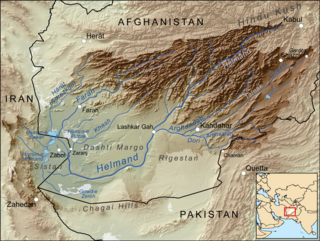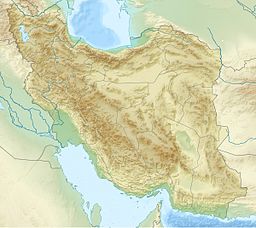
The Geography of Pakistan is a profound blend of landscapes varying from plains to deserts, forests, and plateaus ranging from the coastal areas of the Arabian Sea in the south to the mountains of the Karakoram, Hindukush, Himalayas ranges in the north. Pakistan geologically overlaps both with the Indian and the Eurasian tectonic plates where its Sindh and Punjab provinces lie on the north-western corner of the Indian plate while Balochistan and most of the Khyber Pakhtunkhwa lie within the Eurasian plate which mainly comprises the Iranian Plateau.

Lake Chad is a historically large, shallow, endorheic lake in Central Africa, which has varied in size over the centuries. According to the Global Resource Information Database of the United Nations Environment Programme, it shrank by as much as 95% from about 1963 to 1998. The lowest area was in 1986, at 279 km2 (108 sq mi), but "the 2007 (satellite) image shows significant improvement over previous years." Lake Chad is economically important, providing water to more than 30 million people living in the four countries surrounding it on the central part of the Sahel. It is the largest lake in the Chad Basin.

The Aras is a river in the Caucasus. It rises in eastern Turkey and flows along the borders between Turkey and Armenia, between Turkey and the Nakhchivan exclave of Azerbaijan, between Iran and both Azerbaijan and Armenia, and, finally, through Azerbaijan where it flows into the Kura river. It drains the south side of the Lesser Caucasus Mountains while the Kura drains the north side of the Lesser Caucasus. The river's total length is 1,072 kilometres (666 mi) and its watershed covers an area of 102,000 square kilometres (39,000 sq mi). The Aras is one of the longest rivers in the Caucasus.

Markazi Province is one of the 31 provinces of Iran. The word Markazi means central in Persian. In 2014 it was placed in Region 4.

The Pantanal is a natural region encompassing the world's largest tropical wetland area, and the world's largest flooded grasslands. It is located mostly within the Brazilian state of Mato Grosso do Sul, but it extends into Mato Grosso and portions of Bolivia and Paraguay. It sprawls over an area estimated at between 140,000 and 195,000 square kilometres. Various subregional ecosystems exist, each with distinct hydrological, geological and ecological characteristics; up to 12 of them have been defined.

Arak is the capital of Markazi Province, Iran. At the 2011 census, its population was 526,182, in 160,761 families. The city is nicknamed the "Industrial Capital of Iran".

Lake Hāmūn, or the Hamoun Oasis, is a seasonal lake and wetlands in the endorheic Sīstān Basin in the Sistan region on the Afghanistan–Iran border. In Iran, it is also known as Hāmūn-e Helmand, Hāmūn-e Hīrmand, or Daryācheh-ye Sīstān.

The Tarim Basin deciduous forests and steppe is a temperate broadleaf and mixed forests ecoregion in the Xinjiang Uyghur Autonomous Region of western China. The ecoregion includes deciduous riparian forests and steppes sustained by the region's rivers in an otherwise arid region.

Kavir National Park is a protected ecological zone in northern Iran. It has an area of 4,000 square kilometers. The park is located 120 kilometers south of Tehran and 100 kilometers east of Qom, and it sits on the western end of one of Iran's two major deserts, the Dasht-e Kavir. Siahkuh, a large, semi-circular rock outcropping sits in roughly the park's center.

The Thal desert is situated at 31°10’ N and 71°30’ E in the province of Punjab, Pakistan. Located near the Pothohar Plateau, the area falls under the Indomalayan biogeographic realm and stretches for a length of approximately 190 miles (306 km) with a maximum breadth of 70 miles (113 km). It is bound by the piedmont of the northern Salt Range, the Indus River flood plains in the west and the Jhelum and Chenab River floodplains in the east. It is a subtropical sandy desert that resembles the deserts of Cholistan and Thar geographically.

The Sistan Basin is an inland endorheic basin encompassing large parts of southwestern Afghanistan and minor parts of southeastern Iran, one of the driest regions in the world and an area subjected to prolonged droughts. Its watershed is a system of rivers flowing from the highlands of Afghanistan into freshwater lakes and marshes and then to its ultimate destination: Afghanistan's saline Godzareh depression, part of the extensive Sistan terminal basin. The Helmand River drains the basin's largest watershed, fed mainly by snowmelt from the mountains of Hindu Kush, but other rivers contribute also.

The Lake Chad flooded savanna is a flooded grasslands and savannas ecoregion in Africa. It includes the seasonally- and permanently-flooded grasslands and savannas in the basin of Lake Chad in Central Africa, and covers portions of Cameroon, Chad, Niger, and Nigeria.
Banni Grasslands Reserve or Banni grasslands form a belt of arid grassland ecosystem on the outer southern edge of the desert of the marshy salt flats of Rann of Kutch in Kutch District, Gujarat State, India. They are known for rich wildlife and biodiversity and are spread across an area of 3,847 square kilometres. They are currently legally protected under the status as a protected or reserve forest in India. Though declared a protected forest more than half a century ago Gujarat state's forest department has recently proposed a special plan to restore and manage this ecosystem in the most efficient way. Wildlife Institute of India (WII) has identified this grassland reserve as one of the last remaining habitats of the cheetah in India and a possible reintroduction site for the species.
Toolibin Lake is a seasonal fresh to brackish water perched lake or wooded swamp, in south-western Australia. The lake is contained with a 493-hectare (1,218-acre) nature reserve and it is located about 200 kilometres (124 mi) south-east of Perth, in the Shire of Narrogin, and 40 kilometres (25 mi) east of the town of Narrogin, in the Wheatbelt region of Western Australia. The lake is listed by the Australian Government as a threatened ecological community under the Environment Protection and Biodiversity Conservation Act 1999.

The Mulga Lands are an interim Australian bioregion of eastern Australia consisting of dry sandy plains with low mulga woodlands and shrublands that are dominated by Acacia aneura (mulga). The Eastern Australia mulga shrublands ecoregion is coterminous with the Mulga Lands bioregion.

Astrakhan Nature Reserve is a Russian 'zapovednik' covering an area including the islands and wetlands of the Volga Delta, where the Volga River enters the northwest sector of the Caspian Sea. The landscape is one of extensive reeds, cattails and willows and is an important nesting area for waterfowl and wading birds. The areas is rich in fish, with 50 species recorded, including beluga sturgeon. The reserve is situated in the Ikryaninsky District of Astrakhan Oblast. Since 1975, the territory has been part of a Ramsar wetlands site of international importance, and since 1984 it has been included in the World Network of Biosphere Reserves.

The Jiwani Coastal Wetland is a wetland located in Balochistan, Pakistan, near the town of Jiwani. The site is one of the 19 Ramsar sites in Pakistan and was inducted in 2001.

Rostov Nature Reserve is a Russian 'zapovednik' that protects a variety of sensitive southern European steppe wetlands, the largest herd of wild horses in Europe, and also wetland habitat for birds. The protected areas are divided into five sections that cover the waters of Lake Manych-Gudilo, islands in that lake, surrounding steppe and shore lands. The reserve is situated in the Orlovsky District, of Rostov Oblast, about 100 km northeast of Rostov-on-Don. It is part of a Ramsar Wetland site of international importance.

Belqeys Castle is a castle located in Esfarayen County in North Khorasan Province, Iran. The fortress dates back to the Sasanian Empire.

Hamoon Jazmourian Basin is a Endorheic basin of Iran. In the classification of basins in Iran, it is considered a sub-basin and is a subset of the Central Plateau Basin. The area of this basin is 69,390 square kilometers and the rivers and canals of this basin enter Hamoon Jazmourian Lake.




















